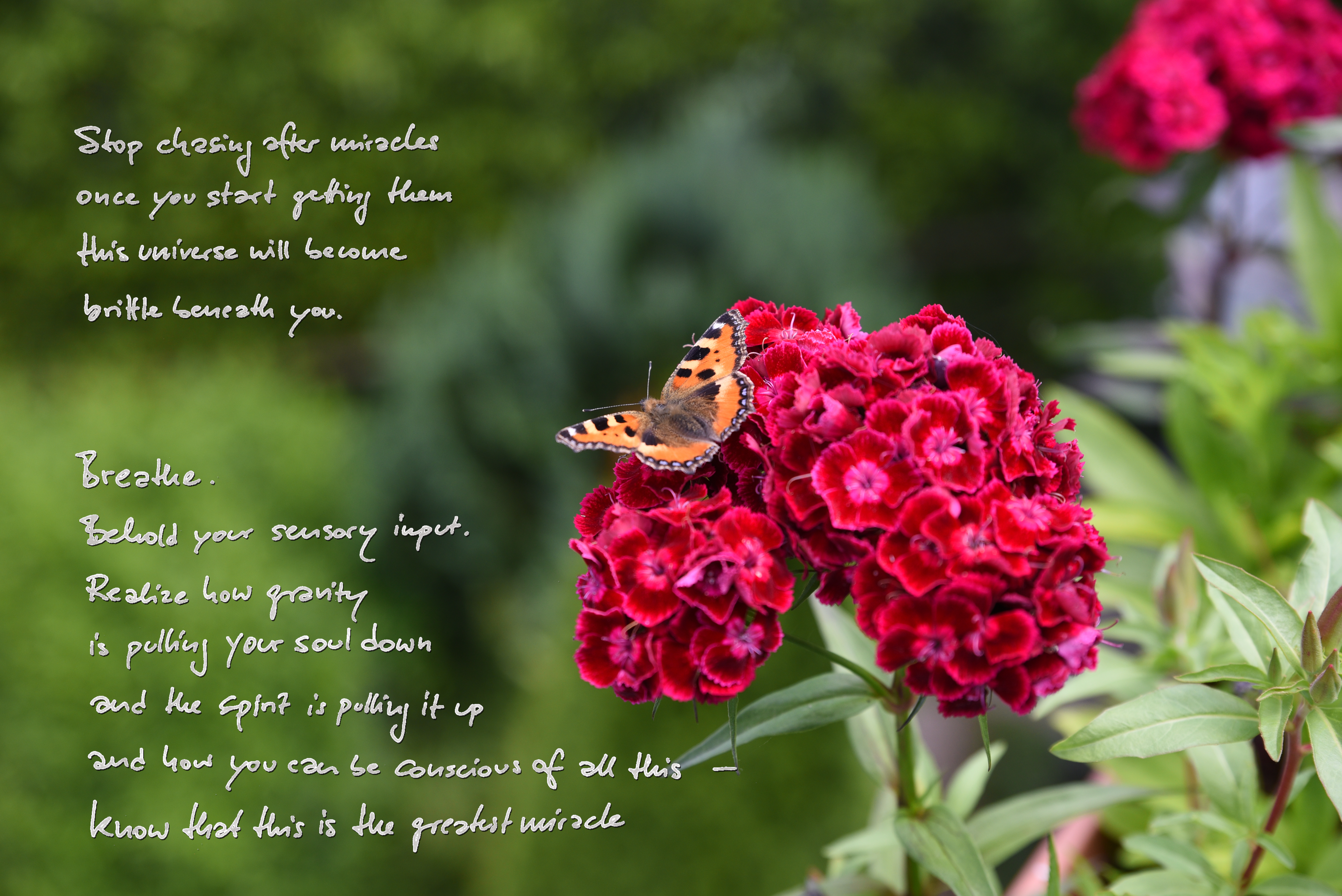Can we make a difference by praying “for” peace, or “for” health, or “for” anything else? By doing so, are we not rather manifesting that peace, health or any other concern we pray about is not here – that instead, it is still lacking, and we are still yearning? Gregg Braden explains (in a YouTube video that since got removed) that we should rather pray peace “onto” areas of conflict. During the Lebanon War, it reportedly was proven that a prayer group made a measurable difference on hostilities, waning when they prayed, and flaring up again after they finished. The rain prayer is another version of the same concept. What we call prayer, is a mental exercise, focusing our thoughts and feelings onto the desired outcome.
Even when we do not actively “pray”, we still think and feel, and thus sending ripples onto the pond. Should we think of prayer more like a substance, a state of mind, a constant meditation?
Starting with gratitude
If we begin by acknowledging how miraculous it is that we even have life, that we were considered worthy to live in times like this, and that we have a role to play, and count our blessings, and show gratitude for the divine will and protection that formed us and brought us so far – then we open up a mode of prayer in which we can direct attention on to desired outcomes that are quantum possibilities, and in our sequential perception of time, are not here yet, but they certainly can be, if we align our will with that of our Creator, and extrapolate that He has protected His creation through all past turmoil. Him being the same forever, why would He suddenly start abandoning us and leave us to our devices? It is not only out of character, it is patently impossible, as becomes clear if we begin to understand a bit more about:
the inner fabric of creation.
Creation is fractal: the same functional principles apply to the micro- and macrocosm. It’s just a question how far we’re able to zoom in and out in order to appreciate this. Researchers used to say that quantum physics “defied” the laws of physics as observed in the macro universe, but now we learn that this is only due to a lack of understanding of the processes involved.
Derek Muller (Veritasium) excellently presents superposition, entanglement and measurement – (plus see precursor video explaining entanglement, and a terrific explanation of what “spin” really is by Matt O’Dowd of PBS Studios). We can apply these principles to the soul of humanity: we all generate ripples around us by our thoughts, words and actions. And it’s all entangled. At the big bang, the moment HaShem opened his mouth to utter the first words, יהי אור, just as the first breath was to come over His lips¹, everything was in one place. Since then, the universe is expanding. (Into what? אין סוף - different topic, though related. as everything.) All separation is just a bubble generating the illusion of space and matter. Our thoughts are influencing the world around us, because of the entanglement.
Michio Kaku argues that while telepathy is possible, entanglement had only been achieved for a few atoms at a time in the lab. However, if we all emerge from one singularity, a state were expansion had not started and space did not exist, then it is logical to assume that one some level, all particles, all quantum states are already entangled. Keep in mind that space is an illusion. The world really is a holographic matrix. “Holographic” means, similar to “fractal”, that everything is reflected in everything.
There is a constant infinite energy all around us. In the pilot wave experiment, again excellently presented by Derek Muller here, it is the speaker that drives the whole process by the power of sound. Our Creator spoke the world into existence, and this is a speech that never stops. If HaShem were to stop speaking for just one instant, the creation would immediately revert to the state of non-existence, as if it had never been². The sounds is always on. Some people are apparently more in tune with those frequencies than others, but the blessing of creation is constantly raining down on us (or traversing us, or however you want to visualize it).
bouncing around in the universe
The impact we have on our surroundings can be small, but even if we remain static, we generate ripples. We can also learn to let ourselves be propelled by our own ripples. This requires a fine sense of balance, like surfing. As we float through life, we leave a trail of influence, creating a pattern that, in the best case, forms a beautifully symmetrical shape and harmonizes with many other bouncy balls. In the worst of cases, we fall back onto the path we came from and cancel out the pattern we created so far. If we go off track, we end up undoing distinctiveness we achieved so far, and missing out on the good we have the potential to generate. Yes we have that power. Teshuva, repentance, becomes very concrete then: We can always turn around and aim upward again, and will create and re-create ripples, symmetry and harmony.
The hurt and injustice we receive from other bouncy balls, from the substrate, or even from the speaker can make us bitter, and we can turn into a black hole, a funnel that sucks up other droplets into our vortex of resentment. In the case of the speaker, we may perceive that “fate” is blowing us into circumstances we do not desire. Yet there are no hurtful or unjust sound waves. This is where the metaphor breaks down a little bit: yes sound can be too loud and damaging to our hearing, but HaShem’s creational energy is never overbearing, never out of tune, never wrong. It is us often not being able to resonate with this blessing adequately.
Our task in this life is to do Tikkun, to help repair and restore. As in the famous quote by the upbeat Zig Ziglar: “it’s not how far you fall, but how high you bounce that counts.” All particles resound in their own unique way. If we feel out of place or disaligned from purpose, we need to start tuning into our Creator’s sound waves.
To me, learning Hebrew from a traditional source plays a big part.
Happy bouncing .
───‹·›───
Notes
- On using body parts for HaShem, see this excellent video of Manis Friedman.
- So explained in שער היחוד והאמונה (Sha’ar HaYichud ve’HaEmunah, “The Gate of Unity and Faith”), the second part of the Tanya written by Rabbi Shneur Zalman of Liadi. Several teaching series in English are available on YouTube. I went through a very worthy 61-part series by Rabbi Tzvi Kilov (here is the introduction, the following videos should then be suggested by the Youtube algorithm; alternatively, contact me for the complete playlist). Also see Shlomo Katz - mind-blows and worldview changes practically guaranteed. It is impossible to summarize the שער in a few words; what stuck with me, and changes my life day-to-day, is the perception that the creation something-from-nothing means that the Creator is constantly invested in His creation. The “normal” state is nothingness. The fact that there is a creation is the constant miracle. And we are right in it, we are part of the pigment, part of the brush, part of the canvass.
───‹·›───

